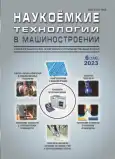THE EFFECT OF VIBRATION TREATMENT TECHNOLOGICAL PARAMETERS ON THE QUALITY OF PRODUCTS, MANUFACTURED BY USING SELECTIVE LASER FUSION TECHNOLOGY
- Autores: Zlobin E.P.1, Haymovich A.I.2, Goncharov E.S.2, Balaykin A.V.2
-
Afiliações:
- Samara University
- Edição: Nº 6 (144) (2023)
- Páginas: 38-48
- Seção: Additive technologies and laser processing
- URL: https://bakhtiniada.ru/2223-4608/article/view/350084
- DOI: https://doi.org/10.30987/2223-4608-2023-38-48
- ID: 350084
Citar
Texto integral
Resumo
The research results presented in this article are devoted to the study of the vibration treatment effect on the surface layer of flat samples made of titanium alloy VT-6 obtained using selective laser melting (SLM) technology. Titanium alloys are the materials, used in various fields of industry due to their unique properties, namely high strength and lightness. However, when treating such materials, there is a number of problems connected with the high hardness and complexity of post-processing products after their growing. Post-processing operations require automation for driving down various types of costs. Vibration treatment is one of the possible solutions to this problem. Within studies a sample roughness was measured and the material removal rate was calculated based on the vibration treatment criteria. The results showed that rough grind-ing of flat surfaces into vibrofinishing equipment is an effective method for achieving the required surface parameters when treating products made of titanium alloys obtained by the SLM method. This can result in improved finish, increased produc-tivity and costs saving. The analysis of the results makes it possible to give recommendations for rough grinding of surfaces made of titanium alloys. The process must be carried out in two stages: 1) to have maximum material removal from the sur-face 2) to improve the roughness. Thus, the results of the study can be helpful for various industrial sectors where titanium alloys are used, also contributing to the further development of technologies for products treatment made from difficult-to-machine materials and obtained by using SLM technology.
Sobre autores
Evgeniy Zlobin
Email: ep.smr@mail.ru
Engine production technologies
Aleksandr Haymovich
Samara University
Email: ep.smr@mail.ru
Evgeniy Goncharov
Samara University
Email: ep.smr@mail.ru
Andrey Balaykin
Samara University
Autor responsável pela correspondência
Email: a_balik@mail.ru
Bibliografia
ГОСТ Р 57558-2017/ISO/ASTM 52900:2015. Аддитивные технологические процессы. Базовые прин-ципы. Часть 1. Термины и определения (Переиздание). Введ. 2017-12-01. М.: Стандартинформ, 2020. Чемодуров А. Н. Применение аддитивных тех-нологий в производстве изделий машиностроения // Известия Тульского государственного университета. Технические науки. 2016. № 8-2. С. 210-217. EDN WLXVCZ. W. Piedra-Cascón, V. R. Krishnamurthy, W. Att, M. Revilla-León. 3D printing parameters, support-ing structures, slicing, and post-processing procedures of vat-polymerization additive manufacturing technologies: A narrative review // Journal of Dentistry. 2021. Vol. 107. - P. 103630. doi: 10.1016/j.jdent.2021.103630. EDN ISRCTC. Бабичев А.П., Зеленцов Л.К., Самодумский Ю.М. Конструирование и эксплуатация вибрационных станков для обработки деталей. Ростов: Изд-во Ростовского ун-та, 1981. 160 с. EDN: YSKOPZ Ющенко А. В., Флек М. Б. Исследование про-цесса съёма металла при абразивной галтовке // Вест-ник Донского государственного технического универ-ситета. 2013. Т. 13, № 3-4(72-73). С. 125-133. EDN RFUKBL. Tarasovskii V. P. Surface Machining of Corun-dum-Ceramic Components by Free Abrasive // Russian Engineering Research. 2020. Vol. 40. No 9. P. 793-796. doi: 10.3103/S1068798X20090191. EDN NGRCFV. Бабичев А.П., Бабичев И.А. Основы вибраци-онной технологии. Ростов н/Д, 1999. 621 с. Назарова Т. И. Микроструктура и механиче-ские свойства на растяжение сплава ВТ6, полученного методом селективного лазерного плавления / Т. И. Назарова, В. М. Имаев, Р. М. Имаев, С. П. Павлинич // Известия вузов. Физика. 2015. Т. 58. № 6. С. 25-29. EDN UBXJDD. Рао С. Методы Тагути: эволюция, концепция и межотраслевое применение / С. Рао, П. Самант, А. Ка-дампатта, Р. Шеной // Методы менеджмента качества. 2016. № 6. С. 50-57. EDN VZYDFL. Ramón V. León, Anne C. Shoemaker & Raghu N. Kacker (1987) Performance Measures Inde-pendent of Adjustment: An Explanation and Extension of Taguchi's Signal-to-Noise Ratios, Technometrics, 29:3, 253-265, doi: 10.1080/00401706.1987.10488231
Arquivos suplementares









